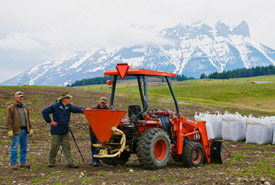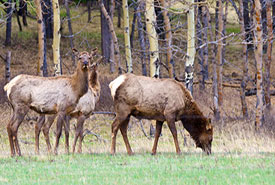Fleming Ranch

Reclamation of Fleming Ranch, AB (Photo by NCC)
Conservation region: Rocky Mountain Front
Natural priority area: Castle Crowsnest Watershed
What's in a name?
Fleming Ranch (originally named the Jarvie Property) is considered an ecologically significant grizzly bear corridor. The Nature Conservancy of Canada (NCC) proposed a name change when the organization purchased the property from the Rocky Mountain Elk Foundation, because the Fleming family were the original owners of the land.
The Fleming Ranch, as it is now called, is an important feature of NCC's conservation efforts in Alberta. The 118-hectare (292-acre) property is mostly open areas of grassland interspersed with trees. The Crowsnest River flows through the property, and it is frequented by elk, deer, wolves, cougars, black bears and grizzly bears.
It is located five kilometres from the town of Coleman.
Reclaiming the land
NCC was committed to conserving this ecologically significant parcel of land, but there was a fair bit of work that had to be completed. Invasive species had taken over the property, and the fence near the forested area was due for an upgrade. The five-hectare (12-acre) gravel pit needed immediate restoration. NCC saw the potential in this land and decided to restore the Fleming Ranch to its natural beauty.
In 2011, plans were made to reclaim the land and bring back native vegetation. Native vegetation is more adapted to local climate, and provides better nutrition for wildlife. NCC invited volunteers from the community to help out with the reclamation project.
Giving the land some tender care
The restoration started with the gravel pit. The late Don Dabbs, an NCC board member in Alberta, was instrumental to the project. He oversaw the initial stages of the reclamation efforts and cared deeply about the property.

Elk, AB (photo by NCC)
NCC wanted to add some vegetation, so soil was laid to get the ball rolling. Later, slender wheat grass was put down along with some barley seed, which will hold the dirt in place. The gravel pit flourished with grass, and what was once an eyesore is now a source of food for elk. Within one season, the grass started to tolerate winter grazing from wildlife. Although the weed battle continues, there certainly isn't the prevalence of blueweed and knapweed that there was in previous years. That is not the end for the gravel pit, however, as a five-year project was put into place.
Volunteers to the rescue
In 2013, NCC’s Conservation Volunteers program held an event on the property to harvest native wildflower and grass species. After a successful event, the seeds were given to professional contractors to distribute around the gravel pit and surroundings, so native species would be reintroduced to the area.
Thanks to the work of NCC supporters, Fleming Ranch is a sight to see, and an area that has become a valuable food source for wildlife. Cattle can also be found grazing during parts of the year. The gravel pit has been flourishing for a couple of years, and signs of native plants are visible on-site. NCC has future plans to acquire more area around the property to conserve as much of the migration corridor as possible




